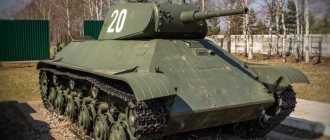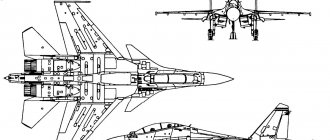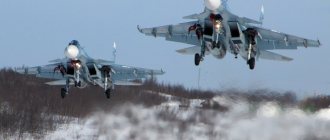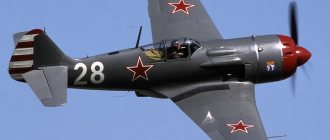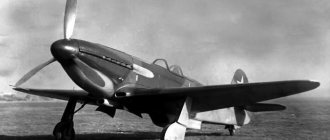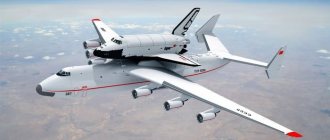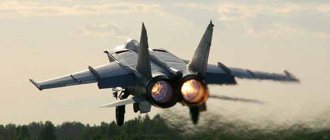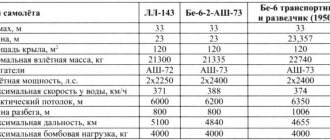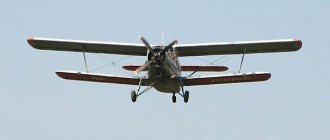A pair of Su-57 fighters performs a test flight. The rapid development of jet aviation in the post-war years allowed designers to create four generations of fighters one after another in a fairly short time, but there was a “hitch” with the fifth. Both in the USA and in the USSR, the military expected to receive such combat vehicles back in the first half of the 90s of the last century, however, this did not happen. Only at the end of 2005, the US Air Force began to receive F-22 Raptor aircraft, which became the world's first serial fifth-generation fighters. Five years after this, the Russian “answer” to the overseas challenge took off for the first time - the T 50, which later received the designation Su-57, but serial production of this machine was only able to begin in 2022.
History of the development of the fifth generation fighter T-50 PAK FA (Su-57)
In the 80s of the last century, two aircraft were created in the United States that stood out noticeably against the background of all other military aviation. These were the F-117 and B-2 - very different combat vehicles both in their purpose and in appearance, which were united by only one thing - they were built using technology known as stealth. This word can be translated as “sneaky” or “secretly,” but more often “stealth” aircraft are simply called invisible, since, according to their creators, they are invisible on the screens of radars and heat direction finders. It is clear that this quality can enhance the capabilities of both fighter and strike aircraft.
F-19 is a mythological, never-existing stealth fighter, information about which was actively promoted in the 80s for propaganda or provocative purposes
In those years, the USSR had already begun mass production of the Su-27 and MiG-29, and the next step was to create the so-called MFI - a multifunctional fighter. Stealth in the radar and infrared ranges was one of the main requirements for the new aircraft, at the same time it had to have some other characteristics:
- Capable of long-term flight at supersonic cruising speed;
- Shortened takeoff and mileage;
- Super maneuverability;
- The ability to equally successfully destroy both air, ground and sea targets.
Special requirements were also imposed on the on-board equipment: the radar was supposed to be made much more powerful than that of fourth-generation fighters, and the software system was supposed to have “artificial intelligence,” making the pilot’s work as easy as possible.
The goal was not to build something like the F-117: the customers were more focused on the F-22, which was already being developed then.
When the USSR collapsed in 1991, the “new Russia” inherited two projects for a promising fifth-generation fighter. The first of them is the MiG-1.44 - an aircraft that makes a strong impression even today. The second was a heavier fighter with a forward-swept wing, later known as the S-37 or Su 47 Berkut. At first it seemed that the MiG should become the “Russian stealth” aircraft, since the S-37 was more of an experimental aircraft. Fate, however, decreed otherwise: although Berkut was indeed destined to shine exclusively at air shows, the “1.44 project” completely froze, since its progress was hampered by a chronic lack of funding.
MiG 1.44 - failed “Soviet stealth”
In the meantime, specialists from the Sukhoi Design Bureau were able to organize serial production of the commercially successful Su-30 aircraft, the proceeds from the sale of which made it possible to develop new aircraft models, despite even the deplorable situation in which the Russian aircraft manufacturing complex was located.
The creation of the prototype of the fifth-generation T-50 fighter officially began in 1999. Two years later, the Russian Air Force once again compiled a list of characteristics that the new aircraft should have. Now it has received the preliminary name PAK FA - a promising aviation complex for front-line aviation. Previously, it was planned to build simultaneously a heavy MFI fighter and a cheaper LFS (light front-line aircraft). Now both of these projects were united. It is possible that this decision was influenced by the experience of the United States, where the F-35, which was originally developed as a “cheap addition” to the more powerful F-22, eventually became, on the contrary, prohibitively expensive.
It is also worth noting that a fundamental decision was made to abandon the creation of a special version of the PAK FA with a vertical landing and short take-off - apparently also under the impression of the difficulties faced by American designers.
received an official order for the development of a promising fifth-generation fighter in 2002. In 2004, India began to be involved in this project, having previously purchased Su-30 aircraft and interested in strengthening its air force. It was assumed that mass production of the new machines could begin in 2015, and the total cost of the work would be about five billion dollars.
The first takeoff of the T-50 from the airfield in Komsomolsk-on-Amur
It is noteworthy that Sukhoi JSC was simultaneously engaged in the project of the RRJ passenger aircraft, now known as the Superjet. Nevertheless, priority was still given to military programs, half of which in one way or another related to the future T-50. Flight prototypes of these machines were built in Komsomolsk-on-Amur, and the first run of the promising fighter took place there at the end of 2009.
Flights began in January 2010. First, the T-10M-10 flying laboratory took off, and at the end of the month the T 50 plane took off from the airfield, and after 47 minutes made a successful landing. From this moment on, the “biography” of the Su-57 entered a fundamentally new stage.
History of creation
The requirement to develop a highly maneuverable and stealthy fighter first came to design bureaus in the late 80s. As planned, it was supposed to replace the Su-27 and MiG-29 in front-line aviation. Therefore, during development, 2 projects were created. One of them was called 1.44, and was developed at RSK MiG, and the second was Su-47, which was developed at the Sukhoi Design Bureau. However, the collapse of the USSR and, as a consequence, the country's plunge into a severe economic crisis led to a lack of funding, and both projects had to be curtailed. True, they managed to release the Su-47 and used it as a flying laboratory. Perhaps for this reason, the resumption of development of a fifth-generation fighter was entrusted to specialists from the Sukhoi Design Bureau.
Flight tests
The first flaws in the design of the T-50 were identified even before the flights began - during technical runs along the runway. In particular, it was necessary to correct the ground braking system and steering. Fortunately, it wasn't too difficult.
The first stage of the test program included seven flights in Komsomolsk-on-Amur, however, only five were completed - one in January and two each in February and March. In April, two T-50 fighters were loaded onto an An-124 and sent to Zhukovsky, the air force base. At the end of the same month, another test flight took place.
T-50 fighter “in the package” after the flight on board the An-124
Supersonic speed was achieved for the first time on March 14, 2011. The total number of flights by the end of October 2013 exceeded 450. Moreover, at least one of the experienced fighters was already equipped with a radar station. The state testing program for the aircraft has not been fully completed (completion is scheduled for this year), but back in 2022, the Su-57 was tested in combat conditions in Syria. As is known, aircraft such as the F-35 and F-22 may be in the airspace of this country and in its vicinity, which makes it possible to compare the capabilities of the on-board equipment of the T-50 and American fifth-generation fighters.
Progress on the creation of the PAK FA (T-50)
The design of the 5th generation fighter began in 2002. The model of the new aircraft was demonstrated in 2004 before the President of the Russian Federation V.V. Putin, and in 2005 funding for development was already allocated.
December 2007 At his press conference, General Director of the Sukhoi Design Bureau M. Pogosyan announced prospects according to which flight and ground tests of the PAK FA (T-50) were to begin in 2009, and serial production in 2015.
12/26/2008 A. Zelin, Commander-in-Chief of the Russian Air Force, stated that our country will receive the first ready-made model of this fighter on 08/12/2009, and in the same year it will take off for the first time. Also, according to him, 3 more test aircraft will be produced in 2010.
08/11/2009 3 aircraft assembled. The first flight is scheduled for November, and the second - for December 2009 (words of the Russian Air Force leadership).
Severe weather conditions did not allow the Sukhoi T-50 PAK FA to take off within the agreed time frame. At the end of 2009, the plane was only able to jog along the airfield runway; the first flight was postponed to January 2010. They tried to keep the appearance of the plane secret until the official press release of the first flight of the 5th generation fighter from the Sukhoi Design Bureau. The pages of the press and the Internet were filled with unreliable data about the new product of the domestic aircraft industry.
12/23/2009 The first runs of the PAK FA T-50 were carried out at the Dzemgi airfield (Komsomolsk-on-Amur).
05/25/2010 After the visit of the delegation of the Public Chamber of the Russian Federation to Brazil and Argentina, one of its members Joseph Diskin said that Brazil is very interested in jointly designing a fifth-generation fighter.
The main purpose of the Su-57
The T 50 is a fifth-generation fighter, developed primarily as a “successor” to the Su-27 heavy fighter. However, the range of the new aircraft is much wider - it is a multi-role aircraft.
The Su-57 can be used to solve the following tasks:
- Interception of air targets;
- Gaining air supremacy;
- Neutralization of air defense systems;
- Search and destroy all types of ground targets, including highly mobile small objects and well-protected stationary fortifications;
- Conducting reconnaissance;
- Electronic warfare.
Unlike the Su-27, which was intended primarily for air combat, the T-50 is versatile, and its stealth makes it much easier to carry out missions. This aircraft is capable of successfully countering fifth-generation American fighters.
Demonstration flight on the Su-57
Export modification
The version of the Su-57 for delivery to other countries (first of all, deliveries to India were planned) was called FGFA. India, together with the United Aircraft Corporation, sponsored the development of the PAK FA and partially took part in it.
However, in 2022, the Indian side withdrew from the project, explaining that the declared characteristics of the future aircraft do not correspond to the actual ones, and also that many of the systems of the projected aircraft do not correspond to the parameters of the fifth generation. At the moment, the potential importing country of the Su-57 is Peru.
Design of the T-50 fighter
In the external appearance of the aircraft, there is a certain similarity with other models created by the Sukhoi Design Bureau, but even with a superficial examination it is clearly visible that the Su-57 is much more “flat” than its predecessors. This form is due, as you might guess, to the desire to reduce radar signature.
Cockpit
The design of the Su-57 canopy will likely undergo changes in the future. However, there is no doubt that the radio-absorbing coating applied on its inside will remain intact. Perhaps the rear part will be redesigned, which so far does not differ in design from a similar element on the Su-27.
The interior of the cabin is somewhat reminiscent of the Su-35S fighter - there is unification in the set of equipment. Three multi-function indicators are installed. Two of them are equipped with fifteen-inch screens, the third is slightly smaller in size and is located on the right side and lower relative to the others. In addition, a wide-angle collimation system is used to display information - part of the data is projected onto the glass of the pilot’s helmet. The cabin has a voice informant and an oxygen generator.
Avionics
If fourth-generation aircraft had one radar station installed, the Su-57 is equipped with a whole radar complex with five antennas. This allows the fighter to be equipped with a “smart skin” capable of monitoring the entire surrounding space. In addition, the equipment also includes an optical-electronic location system.
Canopy of the Su-57 cockpit with transverse binding. Later examples are made with an unbound lantern
The 1,526 transceiver modules that make up the active phased array antenna of the T-50's main airborne radar make it possible to detect ground, sea and air targets at long distances, ensure their stable tracking and launch missiles. There is another radar in the slat of the fighter, which operates in the decimeter range, allowing it to detect enemy aircraft made using stealth technology.
The exact characteristics of the avionics remain secret at this time. In addition, it is possible that they will change over time.
Glider
Like earlier Sukhoi Design Bureau aircraft, the T 50 fighter has an aerodynamic design with an integral layout - the trapezoidal wing and fuselage form a single load-bearing surface. The ratio of these two elements has been changed somewhat as the aircraft has become much flatter. Because of this, the fuselage expanded noticeably.
It is worth paying attention to the flow in the front part of the wing. The pilot can rotate this element, which performs the same role on the Su-57 as the front horizontal tail on the experimental Su-37 - it improves maneuverability. The presence of the PGO as a separate element somewhat reduces the reliability of the on-board systems, but at the same time increases the effective dispersion surface, that is, makes the aircraft more visible, so they decided not to use it.
The mechanization of the high wing is provided by flaperons, ailerons and deflectable tips. The T-50 keels are installed in such a way as to ensure the dispersion of radio waves incident on them.
The flat profile and inclined fins help reduce the EPR of the Su-57 fighter
The use of composite materials made it possible to significantly reduce the weight of the airframe, which, in addition, became simpler in design compared to the Su-27. The designers believe that this will make it possible to simplify the serial production and repair of the aircraft.
Power point
The main engine of the T-50 should be the “type 30”, which does not yet have an official designation. Despite the fact that the fighter has already made test flights with such a power plant, very little is known about it. It is only clear that this is a completely new model. Estimated thrust - up to 18,000 kgf.
At the first stage, AL-41F1 engines were installed on the Russian fifth-generation fighter. Their thrust is up to 15,000 kgf in afterburner, and up to 9,500 kgf in normal mode. The engines, in addition, have controlled thrust vectoring (up to 20 degrees).
Widely spaced nacelles with adjustable air intakes are used to accommodate the engines.
Design
Most of the information about the PAK FA is classified. For this reason, only approximate characteristics of the aircraft are known. In terms of wingspan and length, the Su-57 is larger than the F-22, but smaller than the Su-27. In terms of weight, it probably belongs, like the Su-27, to the class of heavy fighters. The aircraft fully meets all the requirements for fifth-generation fighters: it is inconspicuous (including thanks to a combination of stealth technologies and electronic warfare), has a supersonic cruising speed, is capable of maneuvering with high overloads, is equipped with advanced electronics, and is multifunctional.
Cabin
The Su-57 cabin is single-seat, wider than the Su-27 cabin due to the design features of the aircraft. The equipment is largely unified with that of the Su-35S. There is an oxygen generator. Information is displayed by two multifunctional indicators MFI-35 with a diagonal of 15″, one smaller MFI below on the right, one reserve indicator for displaying current flight information above on the right, a wide-angle collimation system ShKS-5 and a voice informant. It is also known that some of the information will be displayed on the pilot’s helmet glass.
Controls - central control lever and side throttle control. The cabin canopy consists of two parts: the front (visor) and the rear. It opens by sliding the rear part back (similar to the T-10). The rear part of the canopy of the T-50-1 and T-50-3 has a longitudinal binding, while the others (T-50-2, T-50-4, T-50-5) have no binding. It is also known that the cockpit canopy may be significantly modified in the future. A radio-absorbing coating is applied to the inside of the flashlight, reducing radio signature by 30%.
General Director and Chief Designer of NPP Zvezda Sergei Pozdnyakov told Interfax that the Su-57 will be equipped with a fifth-generation ejection seat. According to him, the new seat is superior in a number of parameters to the previous seats found on Russian Air Force aircraft.
A special feature of the new catapult is the use of a multi-program electronic seat motion control system connected to the aircraft information system. The digital computer of this system automatically analyzes the aircraft's speed, its flight altitude, pitch and roll angles, angular velocities and other parameters. At the same time, it takes into account many other data, including the height and weight of the pilot - from 44 to 111 kg. Testing of the new seat is taking place in parallel with testing of the aircraft. According to him, it was planned to complete testing of the new generation ejection seat in 2010. The equipment, oxygen system, and life support system on the PAK FA will also be new. Their development and testing will also be completed this year, the designer added.
Glider
The Su-57 has an integral airframe, made according to a normal aerodynamic design with a high-mounted trapezoidal wing in plan, smoothly coupled with the fuselage. Almost half (visually about 46%) of the wingspan is made up of a wide fuselage. The sweep angle along the leading and trailing edges of the wing is 48° and −14°, respectively. The mechanization consists of wing tips, flaperons and ailerons. The drives of the latter are located under the wing and protrude from its plane as small oblong fairings. There are bevels at the ends of the wing.
The wing has a developed bevel with a rotating front part - an analogue of the PGO - instead of a small rotating edge - the sock. When the engines are not running, the rotating parts of the influx are in a hanging position. More natural is their non-deviated non-working position - in case of failure in flight. On previous aircraft (Su-30, Su-33, Su-34), PGO was used to increase maneuverability due to the lack of engines with UHT. The presence of PGO increases the risk of control failures. Therefore, the Su-35 does not use PGO; to increase maneuverability, engines with UHT are sufficient.
The tail unit includes all-moving trapezoidal stabilizers and fins mounted at a camber of approximately 26° to reduce visibility. At the base of the fins there are small air intakes for cooling the aircraft's equipment. The deflection of the fins is used as an aerodynamic brake to increase drag.
The engines have adjustable ventral air intakes. The engine nacelles are widely spaced and separated by a flat bottom of the fuselage about 1.3-1.4 m wide. There, one behind the other, with a small gap, there are two pairs of doors for the internal weapons compartments. From the rotating part of the wing influx, back several meters, stretch 2 triangular ridges in cross-section, installed under the junction of the wing and fuselage consoles. On the outer sides of these ridges there are doors for the internal weapon compartments.
In the rear part of the fuselage between the engine nozzles there is a tail boom protruding far beyond the nozzles, like on the Su-27, in which a retractable container with the aircraft’s parachute braking system is installed. An air cannon is installed on the right side of the nose of the aircraft, and a retractable boom for in-flight refueling is installed on the left.
The Su-57 chassis is three-post, similar in design to the Su-27 chassis. All stands are retracted in the direction of flight. The chassis track, thanks to the wide fuselage, is 5.5 m. The nose strut is two-wheeled with two landing lights and a mud deflector. The niche of the front pillar is closed by two pairs of doors. The front doors are longer than the rear doors and open only when the landing gear is retracted/released, being in the closed position when the strut is extended to reduce the impact of side winds. The main landing gear is single-wheeled (wheel diameter is 1 m) and equipped with brakes. Their niches are located at the outer sides of the air intakes. When cleaning, the main racks rotate along two axes.
To a large extent, the shape of the Su-57 airframe is determined by the visibility reduction technologies used in its design, which is typical for all fifth-generation fighters.
The weight of the airframe is reduced due to the widespread use of composite materials - according to chief designer A. Davidenko, by weight, composite materials make up 25% of the weight of an empty aircraft, and by surface area - 70%. He also noted that, compared to the Su-27, the Su-57 airframe has four times fewer parts. This reduces labor intensity and reduces production time, which reduces the price of the machine. To protect carbon fiber structures extending onto the outer surface of the airframe from damage by lightning discharges, FSUE VIAM has developed a new lightning-resistant coating for the Su-57, which also reduces the weight of the aircraft.
AL-41F1 engines
The Su-57 prototype, as well as the first production models, which should enter service with the Russian Air Force in 2015, are equipped with the first stage engines - AL-41F1 (Izdeliye 117). This is an aviation turbojet two-circuit engine with an afterburner and controlled thrust vector, created by NPO Saturn on order from the Sukhoi Design Bureau, it allows you to reach supersonic speed without using afterburner, and also has a fully digital control system and a plasma ignition system. Unlike the Pratt & Whitney F119-PW-100 engines for the F-22 Raptor, the nozzle is round rather than rectangular. The second stage engine will be developed within 10-12 years from the date of the start of the tender of the Russian Ministry of Defense, in which UEC and Salyut will participate.
It is distinguished from the engine for the Su-35S (Izdeliye 117S) by increased thrust, a complex automation system, a fully digital control system, a new turbine and improved fuel consumption characteristics.
Type 30
As part of the PAK FA program, a 2nd stage engine is being developed under the symbol “type 30” (product 30; according to the general designer of NPO Saturn, Viktor Chepkin, in the future it may receive the AL index). In December 2014, UEC General Director Vladislav Masalov announced plans to bring it to installation on aircraft and first flights by 2022. In June 2015, he also became aware of the readiness of the technical design of the engine, the development of design documentation for the production of prototypes of the engine, and plans for the production of two prototypes by the end of 2015, which is fully consistent with the government contract and work schedule. On September 2, 2016, KnAAZ General Director Alexander Pekarsh announced that prototypes of the engine had been built and were undergoing ground tests as planned.
The engine is completely new and not an upgrade. It has a new fan, hot part, and control system. According to a representative of UEC, the engine has introduced “many innovations, which in some cases do not have a close analogue in the world.” The first flight of the Su-57 with the Izdeliye 30 engine is planned for the fourth quarter of 2017.
Armament
The fighter is equipped with a 30-mm 9-A1-4071K air cannon, first tested in 2014. The gun was developed by specialists from the Tula KBP. The new gun is a modernized version of the 30-mm GSh-30-1 (9-A-4071K) aircraft gun, produced since the 1980s. Combat load: 1310-10000 kg. For air combat, in weapons bays: 1620 kg (8 × RVV-SD + 2 × RVV-MD). Against ground targets, in weapons bays: 4220 kg (8 × KAB-500 + 2 × RVV-MD). Suspension points: internal 8 or 10; external 8 or 2.
Avionics
Radio and optoelectronic equipment According to Yuri Bely, General Director of NIIP, the radio-electronic system of the Su-57 will be fundamentally new, different from the airborne radar in the traditional sense. Thus, the aircraft will be equipped with not only the main radar station with AFAR, but also a set of other, both active and passive radar and optical location stations, distributed over the entire surface of the aircraft, essentially constituting a “smart skin”. Konstantin Makienko, editor of the Moscow Defense Brief magazine (English) Russian, clarified that the integrated multifunctional radar system of the Su-57 will contain 5 built-in antennas.
Surging Su-57 at the MAKS-2011 air show
It is planned to install on the Su-57 a new radar with an active phased antenna array (AFAR), developed by NIIP, containing 1526 transceiver modules, which will provide the aircraft with a greater detection range, multi-channel tracking of targets and the use of guided missile weapons against them. The phased array plane is located at an angle, which somewhat reduces its power when working against ground targets, but significantly reduces its contribution to the aircraft's EPR. The radar is built entirely on a Russian element base based on gallium arsenide (GaAs) nanoheterostructures and advanced technologies of antenna systems with electronic beam control. The new radar was first presented to the public at the MAKS-2009 air show, where a representative of NIIP said that testing of the radar began in November 2008, work on joint testing with other aircraft systems began in the summer of 2009, and the release of the first radar fully ready for combat use is planned as of mid-2010.
In addition to the main radar, an additional radar for the Su-57 L-band, structurally located in the slat, was also presented at MAKS-2009. The use of an additional radar, separated from the main one both in position and in the frequency range, will not only increase the noise immunity and combat survivability of the structure, but will also largely neutralize technologies for reducing the visibility of enemy aircraft, which are capable of reducing visibility only in a certain range of radio wavelengths. It is assumed that such radars can also be placed in any structural elements of the airframe.
The Sh-121 radar complex includes: forward-looking antenna system N036-1-01, L-band antenna system N036L-1-01 and side-view antenna systems N036B-1-01L and N036B-1-01B.
The radar being designed is N036 Belka with AFAR. The use of the N035 Irbis radar in the early stages is impossible due to the discrepancy between the dimensions, however, the N036 Belka being developed uses some of the technologies used on the N035 Irbis (according to some reports, a significant part of the technologies used on the N035 Irbis will be used in the N036 radar, most characteristics are still unknown). In 2009, the N036 Belka prototype was shown for the first time at MAKS 2009. Characteristics of N036 Belka radar
— Number of PPMs: 1526 pcs — Antenna surface size: 700 × 900 mm As of 2015: The radar consists of a promising X-band AFAR in the nose compartment, two side-scan radars, and an L-band AFAR along the flaps. Presented publicly for the first time at MAKS 2015.
Stealth
Stealth is one of the main requirements for a fifth-generation fighter and means a set of measures taken to reduce the ability to detect an aircraft in the radio, infrared and visible light wavelength ranges, as well as acoustically. This will be one of the factors for increased combat survivability of the fighter.
Reducing the visibility of the Su-57 in the radio range is ensured both by the shape, materials absorbing and reflecting radio waves in the design and coating of the aircraft's airframe, and by electronic warfare equipment. In particular, the edges of the wing and other airframe elements are oriented in several strictly limited directions, and the surfaces are inclined in a well-defined range of angles. The design also excludes the mutual arrangement of surfaces at an angle of 90° to avoid the effect of a corner reflector. Radar-absorbing materials in the airframe structure and coating significantly reduce the strength of reflected signals. In some cases (eg in cabin glazing), reflective materials are used.
In addition, the decrease in radio signature became one of the main reasons for placing some of the weapons in the internal compartments. Thanks to these measures, the reflected signal is significantly attenuated and directed away from the source. As a result, the enemy radar does not receive information about the spatial position and speed of the aircraft. Since absolute stealth cannot be achieved, there is always a signal that, after being reflected from the aircraft, still returns to the source. Its characteristic is expressed by the value of the effective scattering area (ESR), the reduction of which, in fact, is the main goal of measures to reduce radio signature. The value of the RCS of an aircraft (an object of complex shape) significantly depends on the direction from which the radiation comes. As a rule, the ESR of stealth fighters is deliberately made lower in the front hemisphere than in the rear, which is determined by the main tactics of their combat use. It is worth noting that the above measures are most effective against radars with combined receivers and transmitters. It is precisely these radars that are equipped with fighters and other combat aircraft of any enemy. Both air defense systems and short-range air defense systems are equipped with the same radars.
Reduced visibility in the visible range is ensured by camouflage (camouflage) coloring of the airframe. Camouflage coloring can be protective (merging into the background) or deforming (distorting the visual perception of the shape of the aircraft). The latter is achieved by painting the prominent parts and edges of the glider in darker color tones and, on the contrary, painting the non-prominent central parts in lighter colors. The coloring of the first flight prototype of the Su-57 is winter, deforming.
The reduction in thermal (infrared) and acoustic (sound) signature is largely determined by the design of the aircraft engines (see the Engines section).
Also an important role in the stealth of a fighter is played by its ability to quickly receive information about the enemy without detecting itself. To do this, the aircraft must have a system of passive sensors and sensors and reliable information exchange channels.
Comparison of Su-57 and F-22 concepts
The authoritative American publication National Interest published a large review comparing the two only stealth fighters in the world, the Su-57 and the F-22, and came to the conclusion that the Su-57 has a number of advantages over the F-22. According to experts, the Su-57 has an advantage in close combat, but the F-22 has some advantage in long-range combat.
Key points from the experts:
— The Su-57 has an L-band radar in its wings, against which the F-22’s stealth systems are useless, although experts note that this radar is not accurate enough to guide missiles using its data alone. There is no analogue of such a radar on the F-22 and there are no plans at the moment.
— The Su-57 has a special infrared detection radar and is already being produced with it, and the F-22 is only planned to be equipped with a similar system in 2022.
— Experts point out that both aircraft do not have the latest avionics, so the traditional advantage of Western aviation in electronic control and communication systems in the F-22 is not fully realized, and American experts assess many of the F-22 avionics systems as outdated for the current level of the American Military industrial complex.
— The F-22 can take six heavy missiles for long-range combat, and the Su-57 can only take four, but with twice the launch range, which is critical given the stealth capabilities and the very frequent misses of missile launches.
“Experts point out that the stealth capabilities of fighter jets cast doubt on the effectiveness of long-range missiles: there is a high probability of a large number of missed missile launches at long ranges and the likelihood of rapid convergence of fighters increases, and, as a result, maneuverable air combat at a short distance.
— The Su-57 has better super-maneuverability due to changing the thrust vector in three dimensions, while the F-22 can only change the thrust vector in two dimensions, which, according to experts, can cause the F-22 to be defeated in close combat.
— Experts note that the Russian military-industrial complex has had an advantage over the American military-industrial complex for many years due to the missile launch control system in close combat using a special helmet that launches R-73 missiles according to the pilot’s gaze. For the F-22, the same system for the AIM-9X is planned only by 2022: “For a long time, Russian aircraft had the advantage of superior short-range R-73 ... pilot just had to look at an enemy plane to shoot at it . However, the United States finally deployed its own equivalent of the R-73, the AIM-9X... [F-22] Helmet-mounted sights should come in 2020"
Separately, American experts point out that the cost of the Su-57 and F-22 is so high that the performance characteristics of the aircraft may be secondary to the relatively small volumes of their production in reality.
Performance characteristics
Official data about the Su-57 aircraft remains secret. For this reason, its characteristics can be assessed rather approximately, based on open information about the technical specifications and other information published in the media.
Flight characteristics
| Flight range at subsonic speed | Up to 4300 km |
| Range at supersonic cruising speed | Up to 2000 km |
| Service ceiling | 20,000 m |
| Landing run length | 100 m |
| Takeoff run length | 350 m |
| Maximum overload | Positive – 10G, negative – 11G |
| Cruise supersonic speed | 2M |
| Maximum speed | 2.45M |
The eleventh flight prototype of the T-50 with a load on external hardpoints.
The flight range can be increased to 5500 km through the use of two external tanks.
Specifications
| Takeoff weight | 35.5 tons maximum; 30.61 tons - normal, with full tanks. |
| Fuel reserve | 11.1 tons |
| Aircraft height | 4.8 m |
| Length | 19.4 m |
| Wingspan | 14 m |
| Sweep angle | 48 degrees at the leading edge, -14 degrees at the trailing edge, at the overflow – 78 degrees |
| Empty weight | 18.5 tons. |
| Thrust-to-weight ratio | From 0.85 at maximum take-off weight to 1.13 (with incomplete filling of tanks up to 63% of their volume) |
No data characterizing the magnitude of the EPR (effective dispersion surface) of the aircraft has been published. Foreign assessments are hardly worth considering seriously, since they are very far from even the most minimal objectivity. The 5th generation fighter T 50 is slightly larger in size than the F-22, which theoretically could mean that the Russian aircraft is easier to detect on radar, but this is all just guesswork.
Why Russia is delaying the release of the T-50. And do we need a PAK FA at all?
Russia, the USA and China are spending huge amounts of money on fifth-generation fighter projects. Almost invisible, capable of destroying targets in the air, on water and land.
This is the weapon of the future, about which there is too much noise. Hi-Tech Mail.Ru figured out why the American F-35 infuriates Donald Trump, and the Russian PAK FA is still not ready.
5th generation fighters - the last aircraft with a pilot
Jet fighters are the elite of weapons. They are complex in everything from aerodynamics to on-board electronics and weapons. Fifth generation fighters are the pinnacle of aircraft construction based on current technologies.
Why Russia is delaying the release of the T-50
They have become "fashionable" because of their characteristics. Stealthy and highly maneuverable fighter. Flies at supersonic speeds without the use of afterburner. Smart electronics solve individual tactical problems and make piloting easier.
An aircraft that reduces targets in the air, on land and water to ashes. An almost perfect machine. The last drawback, the presence of a pilot, will be corrected in the next generation: fighters will be taught to fly independently. The overloads experienced by pilots create limits to maneuverability. Fifth generation fighters are the last step towards unmanned aircraft.
The United States was the first to arm itself with 5th generation fighters
The USSR and America initiated fifth-generation fighter projects in the mid-1970s. Moreover, at that time the Su-27 and F-15 from generation No. 4 had just appeared, and in many countries only third-generation aircraft were flying.
Predators at a military base in Hawaii
The two superpowers had a taste for it, anticipating a clash in the next conflict of the Cold War period. The race ended in the 1990s with the collapse of the Soviet Union. Russia had neither money nor resources to continue development.
America brought its project to fruition and in 2005 became the first in the world to arm itself with fifth-generation fighters, the F-22 Raptor. “This is probably the best aircraft in the world,” says defense and national security expert Kyle Mizokami. — The F-22 combines stealth, maneuverability and engine power. But everything becomes outdated, and the “ideal fighter” moves forward as technology develops.”
In 2005, the Predator met all the requirements for an A, but the population stalled at 187 aircraft. Production was stopped in 2011. Too expensive.
The United States spent $66.7 billion on design alone, and each aircraft cost the budget another $146 million. The legendary F-16 from the fourth generation, even in its late modification F-16D Block 52, cost $34 million.
Then aircraft manufacturer Lockheed Martin showed an alternative - the F-35 Lightning II. The irony is that the aircraft was born out of cooperation between Lockheed Martin and the Design Bureau named after. Yakovleva. In 1995, the Americans studied the experience of developing the Soviet Yak-141 fighter, which could take off and land vertically. They examined it in such detail that the first F-35 models even looked like a Soviet fighter.
The F-35 Lightning II was pitted against the F-22 Raptor: a fifth-generation utility light fighter for the Air Force and Navy. Stealthy and maneuverable, capable of vertical takeoff and short landing. Most importantly, Lockheed Martin promised to make the Predator cheap.
Developments and aircraft are insanely expensive
Two years ago, the US Marine Corps received its first F-35s. So far, about 250 aircraft have been produced, including those for sale. The first three were sent to Israel.
However, the F-35 is plagued by the same problem that plagues the F-22. Development continues, and the cost has already exceeded $55 billion. The fighters were given price tags with a cost of plus or minus a hundred million, depending on the modification.
The US plans to purchase 2,443 aircraft. This park and its operation will cost America $380 billion by 2030. Donald Trump has latched on to this figure. He intimidated aircraft manufacturer Lockheed Martin back in December.
The F-35 program has gone far over budget. Billions of dollars must and will be saved on military procurement.
Trump nodded at the Boeing F/A-18E/F Super Hornet fighter. Less innovative and advertised, but costs almost twice as much. It worked. Lockheed Martin has decided to reduce the cost of its aircraft to $85 million apiece by 2022.
Russia is 20 years late with the 5th generation fighter project
The estimated cost of the Russian PAK FA fighter is currently $100 million. India was going to make the largest order - for 200-250 cars. In India, based on our fighter, they will create their own - FGFA. However, so far even the Russian Air Force does not have ready-made vehicles.
PAK FA model at the MAKS-2011 air show
The domestic fifth-generation fighter project was revived only at the beginning of the 2000s. They improved developments on the SU-47 and MiG 1.44, but they were outdated. They scraped together all the more or less valuable information and started a new project - “Advanced Aviation Complex of Frontline Aviation” (PAK FA).
At the start, 30 billion rubles were invested in the project. In 2010, a test aircraft was shown to Vladimir Putin. Later it turned out that this version of the PAK FA does not reach the fifth generation: an old engine and foreign electronics. Putin, then prime minister, still liked the prospects and allocated another 30 billion rubles to complete the project.
The entire PAK FA project requires about $3 billion. Pennies compared to the cost of the F-22 and F-35. However, these aircraft are already serving in the armies of different countries, and the PAK FA is only being designed.
Potentially the PAK FA is stronger than the F-35
Being late can sometimes be converted into an advantage. “The F-35 was created when possible adversaries [of the United States] were flying aircraft like the Su-30 and MiG-29. The PAK FA is designed to meet the specifications of the F-35, specifically to counter its advantages,” explains Kyle Mizokami.
The PAK FA should fly faster than the F-22 and F-35: 2600 km/h at maximum versus 2410 and 1930 km/h, respectively. The maximum flight distance without refueling is also impressive: it is 2,700 km, while the F-22 will fly 1,900 km, and the F-35 - 2,200 km.
The benefits will be provided by a new engine, which is being created under the code name “Product 30”. The United Aircraft Corporation (UAC) promised fundamentally new avionics with an “electronic pilot” function and an unprecedented low level of visibility.
The PAK FA will be equipped with the Kh-35UE universal missiles. Because of this, the aircraft is pathetically called a “ship killer,” but so far no one has seen the PAK FA even in a demonstration battle. Flight tests only.
The PAK FA will enter service no earlier than 2022
At first, the fighter was planned to be delivered in 2015, then the deadline was twice postponed by a year. Now the Ministry of Defense is only thinking about purchases within the framework of the weapons program for 2018-2025.
PAK FA T-50
Deputy Defense Minister Yuri Borisov reassures: “The aircraft is undergoing scheduled tests. Three new PAK FA aircraft, which the aircraft plant will deliver in 2022, will additionally be included in the first stage tests.”
Checking the pre-production batch means that the PAK FA may appear in the army only in 2022. Too much is not ready.
Test aircraft fly on old AL-41F1 engines. UAC General Designer Sergei Korotkov said that testing of the new Izdeliye 30 engine will begin this year. The first tests of avionics in the air took place in April, and now the system is being finalized.
There are also difficulties with weapons. The catch is that the designers want to place the missiles inside the fuselage. “This requires the search for additional technical solutions,” explained the head of the Tactical Missile Weapons Corporation, Boris Obnosov.
The Ministry of Defense is buying 4th generation fighters, China is in a hurry to compete with the USA
Comparing the PAK FA with other fifth-generation fighter models is PR. The characteristics of the battle-ready PAK FA can only be guessed at this time.
The Ministry of Defense understands the situation, which is why they buy the previous generation Su-30SM, Su-35S and Su-25 attack aircraft. “The Aerospace Forces have fighters that fully meet the needs of the Armed Forces. There is no need to spend money on purchasing new expensive equipment,” Deputy Defense Minister Yuri Borisov emphasized.
Meanwhile, the marketing race continues. The United States wants to make the F-35 the most popular fighter in the world. 11 countries are planning to buy several dozen cars each.
For export, the F-35A model can be converted into any format. Israel will send its engineers to the Pentagon to create a model of the F-35I. In March 2015, the F-35 began to be assembled on an assembly line in Northern Italy.
The Chinese are accused of stealing technology from the US and Russia to create the J-20
When Japan and South Korea each paid for 40 fighters, China accelerated its own project. In March, the J-20 fighter was quickly shown to the public. Experts noted that the J-20 also has many problems - the reliability of the W-15 engine, avionics, and the effectiveness of stealth technologies. Chinese Air Force General Ma Xiaotian assured that the work will be accelerated and the fighter will enter service in the near future.
It is noteworthy that at the end of 2016, China bought 24 Su-35 fighter jets from Russia. Conspiracy lovers immediately saw in this the desire of the Chinese to copy the Russian machine.
Russia is thinking about a 6th generation fighter
A real battle cannot be won with marketing moves. Many experts doubt the strength and power of fifth-generation fighters. Among them is Pierre Spray, a former military pilot and engineer, a military analyst who worked at the Pentagon.
“This was the great dream of beyond-line-of-sight dogfighting,” Spray explained in an interview with the BBC. — You see someone on the radar at a great distance. You look at a dot on the screen, lock on to the target, press a button, and after 30 seconds the dot disappears.”
Spray believes that the dream remained a dream because the "point" cannot be identified as an enemy or an ally. In a large-scale conflict there will be many aircraft and close combat will have to be fought. In such a situation, many fifth-generation features will be questionable, namely the F-35, PAK FA and J-20.
“Stealth technology makes no sense. No one will look for you using radar - except those sitting on the ground. And they can handle stealth too. There is no stealth for large ground-based locators,” Spray is convinced.
The PAK FA project is already 14 years old. This is an approximate period of lag behind American military aviation, which is adopting the second fifth-generation aircraft.
How superior the F-22 and F-35 are to previous generation fighters in combat is unclear. Military experts believe that “4+” and “4++” fighters do an excellent job of their tasks.
PAK FA remains an image project that is important for further development. To make up for points in the new race with the United States, Russia began developing a sixth-generation fighter. The Sukhoi Design Bureau even showed the sketches to Deputy Prime Minister Dmitry Rogozin. The Commander-in-Chief of the Aerospace Forces, Viktor Bondarev, said that the aircraft will be unmanned and in general work is underway on the seventh generation, Fr.
[/message_box]
Author:
Advantages and disadvantages of the Su-57
Considering that the aircraft has not yet undergone a full test program, and information about its combat use in Syria has not been disclosed, it is quite difficult to assess both the positive and negative features of the T-50 fighter.
The advantages should include:
- The plane is made with self-reliance. It contains no imported parts. In particular, the entire element base of electronic equipment is Russian;
- In terms of its speed, both maximum and supersonic cruising, the Su-57 is confidently ahead of its main rival, the American F-35 fighter;
- The commonality of on-board electronics with the Su-35 simplifies pilot training;
- The stated cost of the aircraft is much lower than that of foreign competitors.
Su-57 in Syria, airfield at the Khmeimim base.
The downsides are more complicated. For example, it is known that India withdrew from the program to create the Su-57, stating that the on-board equipment of this machine did not meet the requirements for fifth-generation fighters. In addition, it was said that the Russian aircraft is not stealth, which puts it in a deliberately vulnerable position. All these statements, happily picked up by the Western press, were not supported by any evidence. We can confidently note only one main disadvantage - the Su-57 has not yet entered service, while the F-35 is already being actively exported.
Cost of Su-57
Due to the fact that serial deliveries of the PAK FA to the Air Force have not yet begun, the cost of purchasing these aircraft has not yet been disclosed to the general public. What is clear is that the cost of the Su-57 for the Russian army will be significantly lower than for foreign buyers.
Based on the price of its closest analogues, we can say that the price of a domestic innovative fighter will be approximately 120–150 million dollars per unit. Thus, the closest in concept is the fifth generation American F-22, which is supplied at a price of $150 million per aircraft.
The fighter's main armament
The T-50 is equipped with a 9-A1-4071K aircraft cannon. It is an improved version of the long-known GSh-30-1. The main weapon system consists of a set of air-to-air and air-to-surface guided missiles. They can be placed in internal compartments (this option ensures maximum stealth of the aircraft), as well as on external hardpoints.
Su-57 flies with weapons bay doors open
The “standard” version of weapons for working against air targets is 8 medium-range RVV-SD missiles and two short-range RVV-MD missiles. Instead of the RVV-SD, it is planned to use the K-77M in the future, capable of hitting highly maneuverable enemy aircraft at a distance of up to 180 kilometers, which will greatly expand the potential of the Su-57 as an interceptor.
To destroy ground targets, up to 8 KAB-500 adjustable bombs or guided missiles with a total weight of up to 4,220 kg, including the latest X-59MK2, can be placed in the internal compartments.
The total weight of the Su-57 combat load reaches 10 tons.
